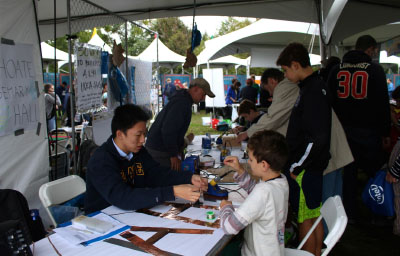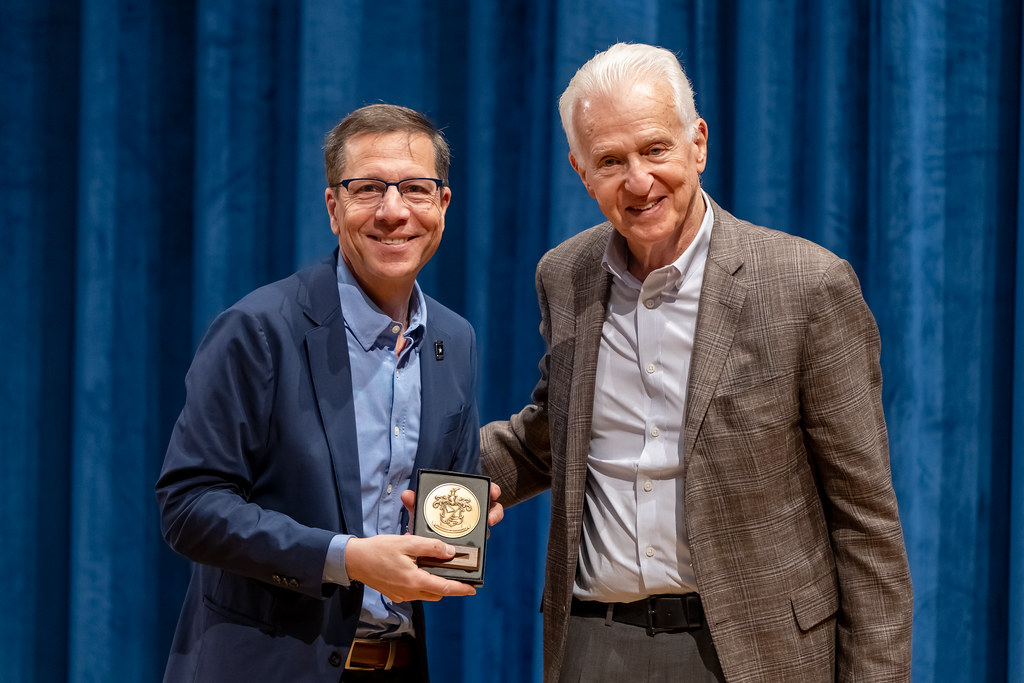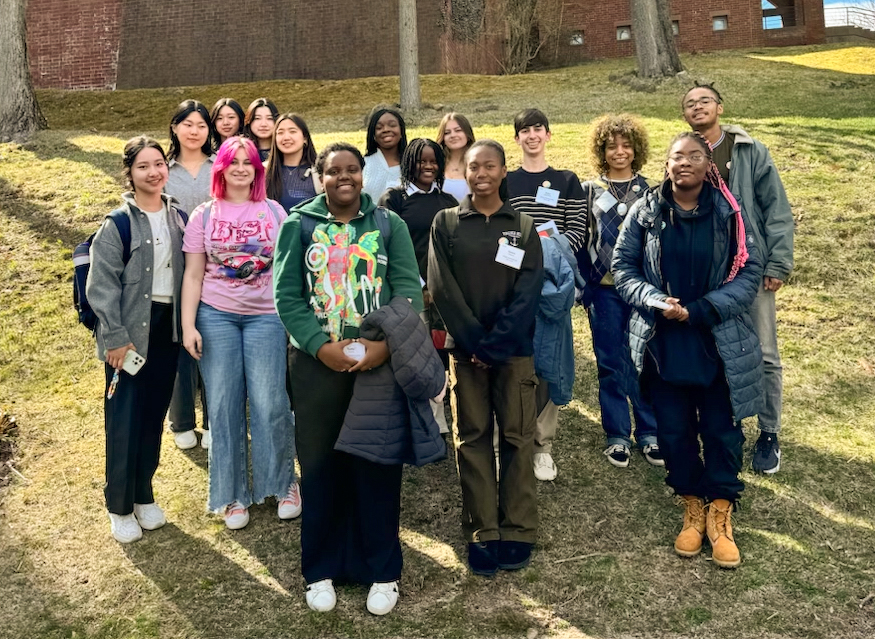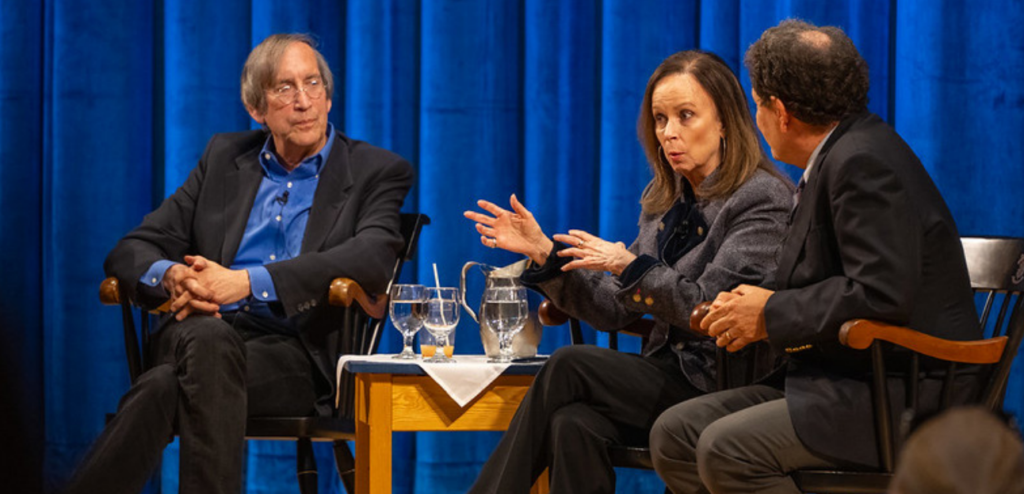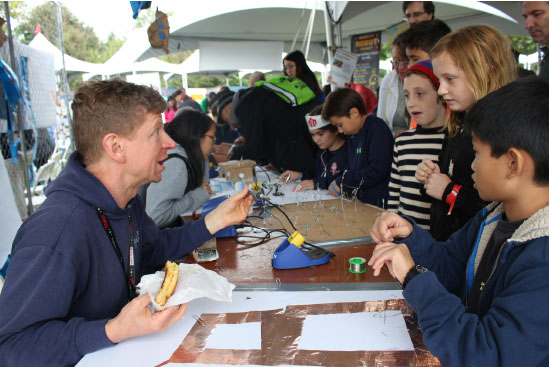
Dr. Travis Feldman, left, teaches children the art of inventing, designing, and tinkering during Maker Faire last weekend.
For some people, 7:00 a.m. on a weekend is too early to be sitting in a Chevy Suburban driving from suburban Connecticut into New York City. For the nine excited students who traveled last weekend to Maker Faire — “the Greatest Show (and Tell) on Earth” — it wasn’t early enough.
The Faire represented a celebration of the Maker movement, which is an umbrella term for independent inventors, designers, and tinkerers. It is a gathering of computer hackers and traditional artisans that has been growing in the last decade, aiming to bring together innovation and experimentation across the spectrum of science, engineering, and art.
Choate’s booth stood in the middle of the Faire’s “Young Maker” zone, where Choate students led a soldering workshop, teaching how to “glue” pieces of metal together. Participants ranged from six-year-olds who were hesitant to hold the hot iron, to adults who had always been curious but had never gotten the chance to learn to solder. The workshop asked students to create sculptures using paper clips and to solder the individual pieces together with the help of the instructors. Final creations included wire people, butterflies, and, more ambitiously, a space shuttle.
The group of students was led by Dr. Travis Feldman, Choate’s i.d.Lab facilitator and a familiar face to those who frequent the Lanphier Center. Dr. Feldman has been attending Maker Faire since 2010.
Dr. Feldman commented on the benefits of events like the Maker Faire: “I think a lot of learning now involves boxing in subjects. Algebra and Geometry are cool, but they become a whole lot cooler when you combine them with other things, like 3D printing or project design.”
He continued, “I think we need to help kids expand their creativity and imagination by giving them space to use what they learn in the classroom to create something amazing. There’s no reason that a fourteen-year-old should be less creative than a four-year-old.”
Dr. Matt Bardoe, chairman of Choate’s math department who helped chaperone the trip, said, “I think there’s a huge benefit to making. I think that students are missing out on a lot of really important ideas and challenges that go with making things, from revising to collaborating, to reaching out — outside of campus — to see what has been d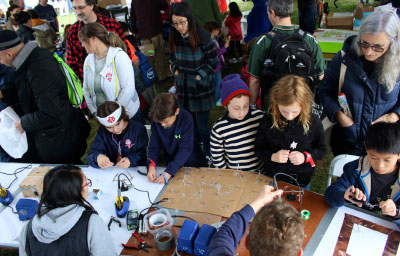 one already and can be done.”
one already and can be done.”
Parents across the board loved the booth and the chance to have their children learn new skills and techniques.
One parent attending the Faire said, “I think it’s incredibly beneficial that children learn how to expand their abilities. They have great imaginations and the more they learn how to use tools and materials in different ways, the easier it is for them to go from what’s in their head to build things and creating them.”
She continued, “This is giving them another set of skills so that when they know that they want to build something, they can start to figure out how to take those steps.”
Another added, “I also think it’s very empowering for them, especially girls, to be able to use these tools and have the power to create and to make things with their own two hands.”
It was a productive experience for the students leading the workshop, too. Annabelle Strong ’19 said, “It was inspiring to be around so many people who share the same passions and interests as me.”
Ben Dreier ’18 agreed, saying, “I had a good time. It was fun to see all sorts of crazy things people had made.”
In addition to the workshop, the booth showed off some student creations from the School’s i.d.Lab, such as “50 different ways to repurpose a $0.99 IKEA bag” from the Design Thinking class taught in the i.d.Lab, and plans for a robotic fish from Will Wu ’19.
Charlie Schlager ’19 also displayed a solar-powered drone that he had built over the past year. He had wanted to figure out “a way to increase the flight time of the drone while keeping its balance and not weighing down the drone with more batteries.” After months of research, experimentation, and prototyping, Schlager finished the drone, which is now able to fly for 13 minutes.
For students like Charlie, the Maker movement also represents a new trend in learning. “Although many people can learn just through conventional means, there are also a fair number of us that, unless we can take things apart and put them back together, will never fully understand what we’re learning.”
Dr. Bardoe agreed, saying, “I think there’s a huge benefit to making. I think that students are missing out on a lot of really important ideas and challenges that go with making. From revision to collaboration, to reaching out — outside of campus — to see what has been done already and can be done.”
He continued, “I think we will almost certainly go again.”

